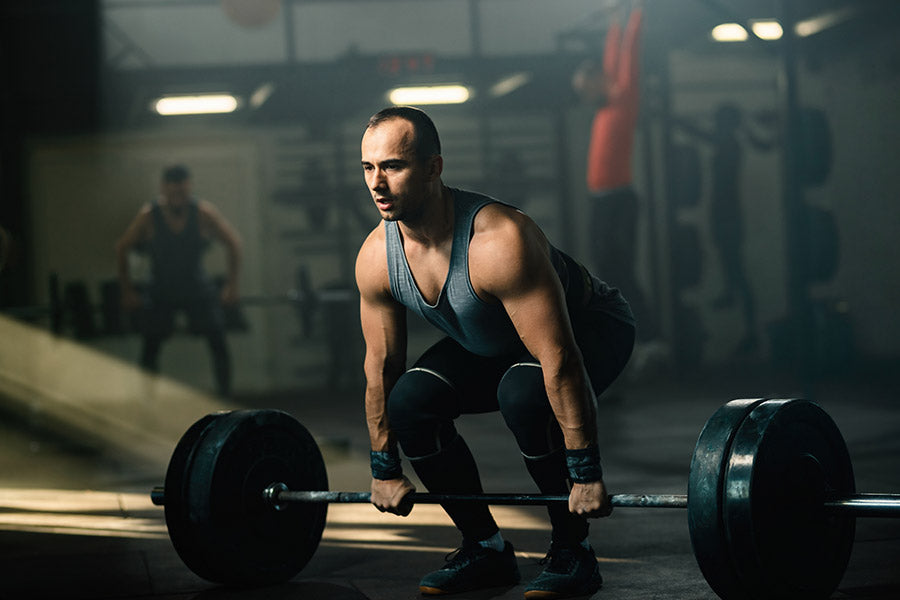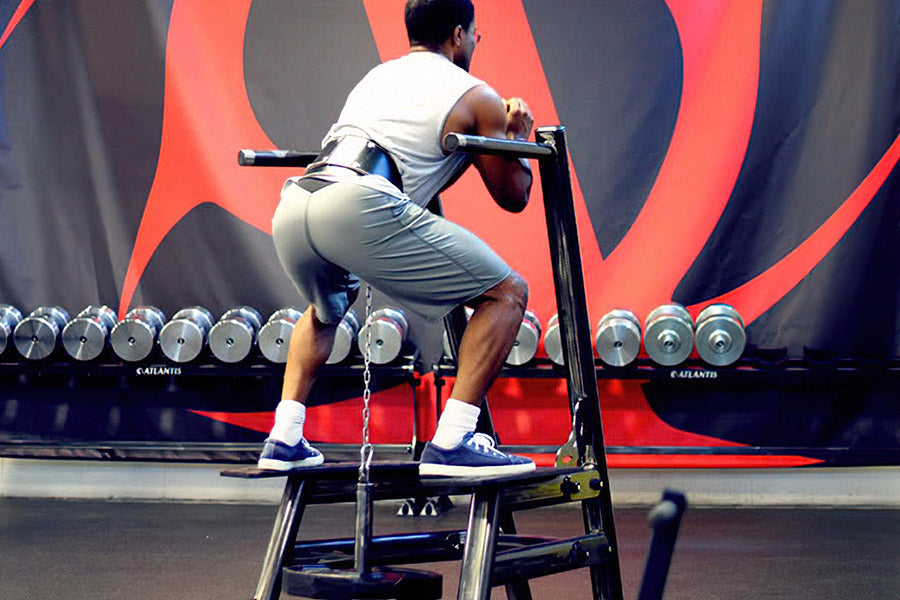Imagine a weightlifter. Chances are you're picturing someone with a huge chest, arms, and tree-trunk legs. Now imagine that same weightlifter squatting down to pick up a barbell. The movement is so natural that you probably didn't even notice how complicated it is.
But if you think about it, the squat is a pretty impressive feat of human engineering. The hip belt squat is a variation of the traditional squat that takes advantage of our unique anatomy to allow us to lift more weight with less risk of injury. The critical difference is that instead of resting the barbell on our shoulders, we place it around our waist, using our hips as the fulcrum point.
It may not sound like a big deal, but it makes a difference. By shifting the center of gravity, the hip belt squat enables us to safely handle heavier weights than we could with a traditional squat. And because the movement puts less stress on our knees and lower back, it's also an effective way to prevent injuries.
If you want to add some serious firepower to your workout routine, the hip belt squat is the exercise for you. Want to know more about them? Well, come along!
What are Hip Belt Squats?
There's no denying that the squat is one of the most important exercises for building lower body strength. But, if you're dealing with pain or injury, performing traditional squats can be difficult, if not impossible. That’s where the hip belt squat comes in.
This versatile and effective movement allows you to work around pain and injuries while building huge legs. Using a belt worn around the hips, you take the strain off your lower back and knees, making it possible to squat heavy weights without pain.
In addition, the hip belt squat targets your quads, glutes, and hamstrings more effectively than traditional squats, making it an ideal accessory movement for building massive legs.
It is best to perform this unique squat variation using a belt squat machine created by Louie Simmons in 1975. After suffering a significant back injury, Louie had to come up with new ways to squat properly, which led to the creation of his invention.
As belt squats have grown in popularity over the past few years, numerous machines with varied variations have joined the market. And they are definitely worth buying for all the modern gyms.
Proper Hip Belt Squat Form

As already mentioned, the ideal way to perform belt squats is using a machine, but many gyms don’t have them. So, what’s the best way to do them? The most common method of performing hip belt squats without a machine is to make a "V" with two benches or boxes while standing, with a weight hanging from a dip belt.
First, create a V-shaped setup by placing two flat workout benches (or highly robust non-tipping wooden platforms) at the same height. The benches at the opening end of the "V" should be far enough apart to suit the width of your preferred squatting position.
After that, put a strong chair, box, or weight plate in the middle of these benches. This will be your loading platform for the weight. Select a heavy dumbbell or plates and set it on the improvised loading station.
Note: When standing on these benches, the dumbbell and the loading platform should be about knee height.
Next, rise and adopt a wide posture of 18 to 24 inches immediately over the loading platform and extend over the flat workout benches. It’s your choice to decide how far apart your feet should be. You need to feel secure and at ease.
Place the hip belt around your glutes and upper hips. Place a dumbbell or barbell plate close to your crotch so that it is snug but not uncomfortable. Attach the weight to the hip-belt chain. Lift the dumbbell from the loading platform after standing up straight. Remove the loading platform (the spotter will do this).
Step out 45 degrees laterally with parallel feet. The power-producing outside edge of the foot will receive stress rather than the weaker inner side thanks to the slight action of rotating the feet out and an 18 to 24-inch heel-to-heel stance.
Your shoulders and hip joints should align as you stand up straight. Never hunch your back or bend so that your chest collapses. If you do, your equilibrium and weight will move to your heels, and you'll place greater strain on your spinae erector muscles, which is an issue with many thighs and back workouts but not with the hip belt squat.
One technique to get the proper feeling of a flat back with a slight arch is sitting erect on a stool or bench. Take a deep breath and raise your chest as high as possible to touch your chin. When done correctly, it will automatically tighten the muscles in your back, giving the impression that your spine and back are locked into place.
Tommy T. Kono, an eight-time Olympia weightlifting champion, developed this technique. In addition to using this exercise, which he called the "pouting pigeon," as stated, he also advised using it before starting pull-in exercises like snatches, cleans, and deadlifts.
Now inhale as you are ready to start your squat descent. As you gently and controllably descend, distribute your weight evenly, and stop about three inches above parallel. Later, as your strength and flexibility improve, you can break parallel by letting the hip joint drop two to four inches below the level of the knee joint, but never at the cost of the integrity of the knee joint. You can think about performing each rep during this negative phase at a calm, controlled pace.
Your hip joint should travel forward slightly as you lower yourself into the squat while keeping your knees and shins in line. (Bring the hip joint as near as possible to the knee joint so that both hips are over the instep or middle of the foot at the lowest position.) Never allow the knees to adduct or abduct.
Start the ascent immediately after completing the hip belt squat's negative phase. Keep in mind that even a delay of 0.5 to 1 second can result in you losing the priceless elastic muscle energy required for the initial drive out of the power pocket. Remember to use a faster speed when doing the climbing or concentric component of the lift.
As you ascend, keep your back straight and your chest high while lifting your head, chest, and shoulders. The hips will rise more quickly than the shoulders if you push your legs first. Your upper body will slant forward, tipping your equilibrium toward your heels.
Related Article: What is a Dip Belt: Everything You Need to Know
Benefits of Hip Belt Squats
The weight distribution across the body in the hip belt squat is its most evident advantage. The exercise avoids the most frequent issues people experience with conventional barbell back squats, where the weight is loaded on the shoulders.
Those who frequently perform hard back and front squats can continue to engage their legs without worrying about the harms of excessive spinal compression and shear forces, thanks to the reduced spinal loading made feasible by this position. Lifters who already have back or shoulder issues need to exercise extra caution.
Hip belt squats are one of the only true squat patterns exercises you can perform without using the back, shoulders, or other stabilizing muscles. Leg presses and hack squat machines have their place, but they also remove the stabilizing muscles from the movement and still load them to some extent.
Additionally, this is always useful. The exercise allows you to go to or almost to failure without running the risk of a loaded barbell landing on your head.
With such a low risk/reward ratio, the hip belt squat is a great way to increase training stress and, eventually, strength and size gains.
Finally, because of the lower center of gravity and the opportunity to use their hands to stabilize throughout the movement, lifters with stability issues, such as amputees, people with specific leg injuries, and people with neuromuscular diseases, can benefit from the hip belt squat.
Belt Squat Variations and Alternatives
The belt squat is not the only way to get a great leg workout. There are plenty of other squat variations and alternatives out there that can help you build strength and power. If you're looking for a challenge, try doing the following instead!
Related Article: Power Muscle Burn Leg Workout for Intermediate-Level Fitness Enthusiasts
Belt Squat Variations
These are some of the most effective belt squat variants, demonstrating how functional the belt squat machine is.
Belt Bulgarian Split Squats

Split squats are a fantastic unilateral exercise to include in your lower-body workouts. They'll work every muscle in the lower body and have amazing benefits for balance. Here’s how you can do it:
- Wear the belt. Start by standing with your rear foot lifted and your feet shoulder-width apart.
- Lower your body until your front thigh is parallel to the ground while maintaining weight on your front foot.
- Take a little pause before pressing through your front foot to return to the initial position.
Belt Sumo Squats

The sumo squat is one of the most powerful leg exercises for athletes to tone and develop the muscles in the legs and butt. But they're not just for show; they can also aid flexibility, strength, and balance. Proper form is essential for a successful sumo squat.
This exercise, sometimes called the plié squat, strengthens your core while working your inner and outer thighs, glutes, and hamstrings. It's also gentle on your joints because it has low impact. However, the belt machine will add additional resistance. Here’s how you can do it:
- To begin, place your feet wider than shoulder-width apart on the belt squats machine and point your toes outward at a 45-degree angle.
- Squat down while keeping your knees tracking over your toes and your weight in your midfoot.
- Press up to the starting position once your thighs are parallel to the floor. Remember to breathe in on the way up and out on the way down.
- Repeat 10 to 12 times.
Belt Squat Marches

This motion is excellent at simulating a loaded carry. It enables you to work the lower body intensely while deloading the spine. Marches are the perfect exercise when regular squats have exhausted your lower back, but you still want to develop your glutes. And best of all, belt marches are excellent for hip flexor training. Here’s how you can do it:
- Stand directly over the belt machine.
- Tighten your abdominal muscles to keep your torso rigid.
- Consider the driving force through your heels as you pick your feet up and stomp down in a marching motion.
- Gradually increase the knee drive.
- Repeat for appropriate reps.
Belt Squat Bent Over Row

You can use the belt squat machine to train your upper body. Connect a handle attachment from a cable pulley system in place of a belt. Perform your bent-over rows while stooping. Here’s how you can do it:
- Start with holding the attachment while standing.
- Your upper body should be parallel to the floor as you stoop forward.
- Push the elbows behind the body while retracting the shoulder blades.
- Slowly raise the attachment toward your lower abdomen before returning it to the starting position.
- Repeat as many times as necessary.
Belt Squat Romanian Deadlift

Any version of the deadlift, including the Romanian, is also an option with the belt squat machine. However, utilizing a belt will lessen their effectiveness because these workouts primarily target the posterior muscles. Use a straight bar attachment in its place and handle it like a barbell.
The advantages of doing one with a barbell still apply, but this is a fun variant you can utilize sometimes. Additionally, you could incorporate this with the bent-over row for some challenging supersets. Here’s how you can do it:
- Hold the bar above your shoelaces as you stand with your feet hip-width apart.
- Deadlift the bar till your hips and knees are locked out using a double overhand grip that is a little wider than hip-width.
- Pushing the hips back and stretching forward to get the bar correctly below knee length is how to start a Romanian deadlift.
- Be sure to extend the entire leg during the exercise.
- Repeat.
Belt Squat Alternatives
Belt squat machines are among the less frequent equipment found in big-box gyms, as indicated in the introduction. That does not exclude you from doing them or something similar, though. Here are the most excellent belt squat substitutes for those who don't have access to this magnificent machine.
Landmine Belt Squat

The landmine configuration is one of the gym's most adaptable and powerful overall. They create a fantastic belt squat variation in addition to all the other landmine movements you may perform!
Some gym attendees would admit it's their preferred belt squat variation compared to the belt squat machine.
As with any previous landmine activity, you must first create a landmine. However, we advise against placing a dumbbell on top of a landmine row attachment and pushing it into a corner. That might be effective for some workouts, but the weight and force's direction may not be ideal for a landmine belt squat.
Next, add the desired weight to the barbell. You might wish to use smaller plates to allow for the complete range of motion. Lastly, put on a dip belt and encircle the barbell with it.
As you don't want the plates to strike the ground when you squat, you want to ensure there isn't too much slack.
Cable Hip Belt Squat

This belt squat variant is just one of the fantastic cable machine leg exercises available. This exercise is excellent, especially for the ones who are just starting.
The pulley system must be initially put on the lowest level while setting up the cable machine, which is a very simple process. Next, put on the hip belt, attach it to the pulley system, and step back a few steps.
Do a squat now in a manner comparable to a regular belt squat.
FAQs
1. How effective are belt squats?
It is difficult to say how effective belt squats are, as limited research is available on this topic. Some suggest that belt squats may be beneficial for building muscle strength and endurance, as they allow users to perform exercises with heavier weights than they could typically lift.
However, other experts point out that belt squats may not be as effective for training the quadriceps muscles of the thighs since these muscles do not get as much direct stimulation from the movement.
Ultimately, more research is needed to determine the actual effectiveness of belt squats and whether they can offer any real benefits for fitness and performance.
2. Are belt squats better for your back?
There is no clear answer to this question, as many factors may influence whether belt squats are better or worse for your back. For example, the type of belt used, how much weight you are lifting, and your overall fitness level can all impact the safety and effectiveness of belt squats.
It may be best to consult a healthcare professional or personal trainer to determine whether belt squats are right for you and to receive specific recommendations on using this exercise safely and effectively.
3. How much does a belt squat weigh?
Most belt squat machines are constructed with a 45-pound trolley and a 1:1 weight ratio. Therefore, the starting weight is the same as it would be with a barbell.
4. Who invented the belt squat?
Louie Simmons invented the belt squat in 1975.
The Bottom Line
Now that you know all there is to know about hip belt squats, it’s time to give them a try. Start with lighter weights and perfect your form before moving on to heavier loads. As with any exercise, listen to your body and never push yourself too hard. With proper form and execution, you’ll soon see the many benefits of hip belt squats for yourself – improved mobility, increased strength, and a lifted booty, just to name a few! Even if you don't have access to the machine, you can do its variations or go for the alternatives.








